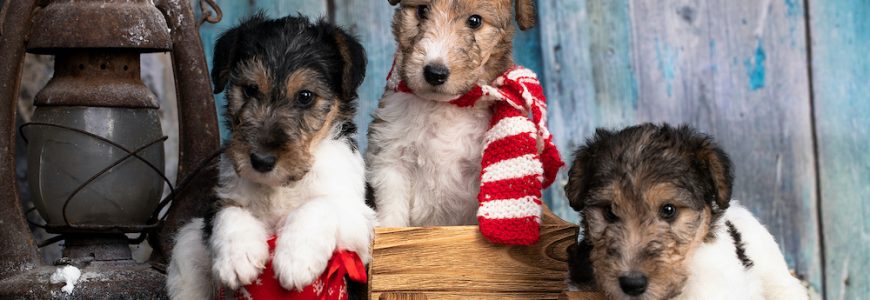Did you get a puppy for Christmas? Bringing a new puppy home can be such an exciting time, but it can also be somewhat stressful as everyone makes adjustments to integrate the new puppy into the household. Preparation in advance of his arrival can lessen this stress and help ensure his lifelong success with your family.
Preparing for a new puppy includes “puppy-proofing” your home and yard, acquiring the necessary supplies and equipment, choosing your pet’s health and safety team, and establishing house rules and routines.
Puppy-proofing your home
When you have a pet, you have a furry toddler for life. Look for potential hazards from your puppy’s perspective. What looks safe and tidy at your height may be completely different at their level. It’s up to you to limit the dangers they may encounter. Here are some things to consider:
- Put away floor plants, shoes, clothing, and any breakable or small objects – basically anything that could be hazardous if ingested or that you don’t want turned into a chew toy or bathroom spot.
- Lock up cabinets and secure hazardous materials to make sure your puppy doesn’t have access to chemicals, medications, detergents, household cleaners, alcohol, or toxic foods.
- Secure electrical wires and cords. Keep them as far out of reach as possible, or consider covering them in plastic sheathing or PVC tubing.
- If you have children in the home, make sure they put away their toys and small parts/accessories. As a general rule, if the item is smaller than the puppy, put it away.
- Check under and behind furniture, tables, cabinets, and appliances for potential hazards.
- Set up a crate or other “safe place” that your puppy can make into his den.
- Clear the yard of hoses, tools, toys, and other objects your puppy could chew on or try to eat. Secure lawn products and chemicals including fertilizers, pesticides, insecticides, paint and paint thinner, and antifreeze.
- Install a proper fencing system and check for potential escape routes. Make sure your dog won’t be able to jump over or dig under the fence.
Supplies and Equipment
Some basic necessities to consider are:
- Food and bowls. Get a small amount of your puppy’s current food and the new food you will be feeding him (hopefully a high-quality and species-appropriate food) so you can slowly transition the puppy to the new food over a week or two. Stainless, ceramic, and glass bowls are best.
- A travel crate to bring him home and a wire crate for housetraining and safely containing your puppy when you aren’t home.
- Washable bedding for inside the crate and elsewhere.
- A flat cloth or nylon collar, harness, and both a short leash (6 feet) for walking and a longer leash (10 feet or more) for training.
- Grooming tools including combs, brushes, shampoo/conditioner, scissors, nail clippers, styptic powder, toothbrush and paste, etc.
- Safe chew toys, interactive toys and fetch toys. Avoid squeaky toys in the teething stage because the squeakers can be choking hazards, and rawhide chews due to potential choking and gastrointestinal distress issues.
Pet Health and Safety Team
Research pet professionals who will help you keep your puppy safe and healthy for life. These include your veterinarian and animal emergency center, and depending on your needs, may also include a positive reinforcement dog trainer, pet sitter or boarding facility (2-3 trusted and reliable options), and groomer. Holistic care such as massage, acupuncture, energy medicine, and chiropractic care can offer additional support for lifelong health and vitality.
House rules and routines
Rules and routines are especially important if there is more than one human in the house, to encourage consistency and clear boundaries for your puppy. To develop a secure bond with your puppy based on mutual respect, trust and cooperation, implement nonviolent techniques to keep your puppy out of trouble and reinforce desired behaviors. Decide on the following before bringing your puppy home.
- Who will be responsible for walking/exercise, feeding, and training your puppy? Who will let him out for bathroom breaks and where?
- What behaviors will you encourage and how will you correct his mistakes?
- Where will your puppy be during the day, will he be allowed on the furniture, and where will he sleep?
Your puppy has so many new things to learn and experience. Be loving, patient, and kind as he adjusts to his new life with your family. With proper love and care, your dog will grow into a great companion.
Happy Holidays!

